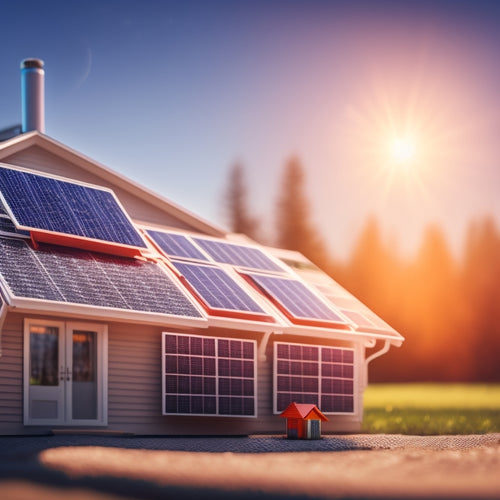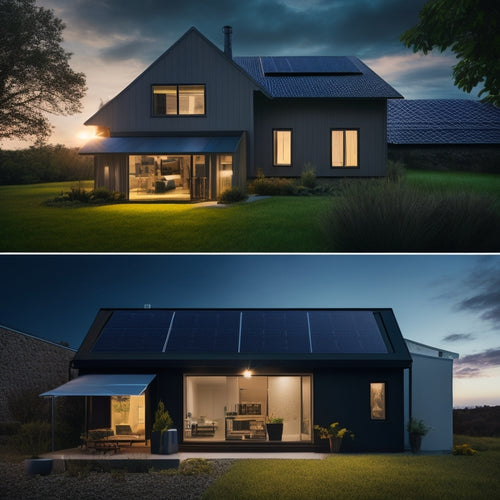
Minimizing Shade Impact on Panel Efficiency
Share
You can minimize the impact of shade on your solar panel's energy output by identifying and addressing sources of obstruction, optimizing panel placement and orientation, and leveraging technologies like bypass diodes and optimizers to mitigate energy loss. To start, pinpoint obstructions like tree shade patterns and building shadows, and consider environmental factors like light diffusion. Then, adjust your panel angle and orientation to track sunlight throughout the day and seasons. By combining these strategies, you can considerably reduce the impact of shade on your panel's efficiency - and there's more to investigate to maximize your energy output.
Overview
- Proper solar panel placement and optimal orientation can mitigate shading effects and enhance sunlight exposure to minimize shade impact.
- Identifying sources of shade loss, including tree shade patterns and building shadows, is crucial for evaluating and reducing shade loss on solar panels.
- Bypass diodes and optimizers can increase overall system efficiency by allowing current to bypass shaded cells and providing granular control over energy harvesting.
- Regular inspection and cleaning of solar panels every six months are essential for optimal performance and maximum sunlight absorption, reducing shade impact.
- Adjusting panel angle and orientation based on performance monitoring data can optimize performance and reduce shade effects, enhancing overall system efficiency.
Understanding Shade Effects on Efficiency
Shadows cast by trees, buildings, or other obstructions can greatly impact the energy output of your solar panel system. Understanding how shade affects your system's efficiency is vital to maximizing your energy production.
Proper placement of solar panels can minimize shading from trees and structures, and trimming or removing trees can enhance sunlight exposure strategic placement.
Shade impact can be measured through efficiency metrics such as solar irradiance, which decreases when your panels are shaded. The duration of shading also plays a significant role, as extended periods of shade can greatly reduce energy output.
Proper panel orientation and installation techniques can help minimize shade impact. Additionally, environmental factors like light diffusion can influence the amount of energy your panels produce.
Identifying Sources of Shade Loss
When evaluating shade loss, you need to pinpoint the sources of obstruction. Tree shade patterns, building shadow effects, and object obstruction analysis are essential factors to take into account, as they can greatly impede solar panel performance.
Vegetation growth, as mentioned in environmental factors impacting performance, can cast shadows, decreasing solar efficiency and attracting wildlife.
Site evaluations are vital for addressing soil erosion and controlling vegetation, with foundation systems and vegetation barriers helping to mitigate risks.
Tree Shade Patterns
Identifying tree shade patterns is vital in determining the sources of shade loss, as this knowledge allows you to take targeted measures to mitigate the impact.
You need to evaluate factors like tree growth, shade duration, and leaf density to understand how they affect your solar panel's performance. When selecting solar panels, it's essential to choose high-efficiency panels with a minimum 25-year warranty to guarantee reliable energy production.
Additionally, using energy-efficient appliances and proper insulation can reduce energy consumption and minimize shade impact.
Seasonal changes, canopy coverage, and sunlight angle also play an important role in shaping tree shade patterns. By using shading models, you can analyze the movement of shadows and determine the best panel placement.
Foliage type and environmental factors, such as wind direction and soil moisture, also influence tree shade patterns. By understanding these factors, you can minimize shade impact and maximize your solar panel's efficiency.
Building Shadow Effects
As you assess the impact of shade on your solar panel's efficiency, you'll want to broaden your scope to include building shadow effects, which can be just as detrimental as tree shade patterns.
Building shadows can cast intense shade on your panels, reducing their efficiency. Structural design, urban planning, and terrain considerations can all contribute to shadow intensity.
Sunlight angles and seasonal variations should also be taken into account, as they can affect the duration and severity of building shadows.
To optimize solar access, conduct a shading analysis to identify areas where building shadows will have the greatest impact.
Consider adjusting panel orientation to minimize the effects of building shadows, and account for weather effects to guarantee maximum energy output.
Object Obstruction Analysis
Your solar panel's efficiency hinges on careful object obstruction analysis, which involves pinpointing sources of shade loss from various objects surrounding the installation site. This step is essential to minimize energy loss and guarantee ideal performance. To identify potential obstructions, consider the following factors:
| Object | Shade Impact |
|---|---|
| Trees | Seasonal shade variation, depending on foliage |
| Buildings | Fixed shade patterns, influenced by solar panel orientation |
| Fences | Partial shade, dependent on height and proximity |
| Terrain | Topography-induced shade, affecting panel tilt and azimuth |
Optimizing Panel Placement Strategies
When evaluating a site for solar panel installation, one essential consideration is the placement strategy.
You'll want to optimize panel placement to minimize shade impact and maximize energy output. Start by conducting a site analysis to determine the best solar array layout, taking into consideration roof orientation, installation height, and local weather patterns.
Consider adjusting the panel angle to track sunlight throughout the day and accommodate seasonal shading. You may also want to assess the benefits of fixed versus adjustable mounting systems.
Additionally, consider ground reflection, which can affect energy output. By carefully planning your panel placement, you can guarantee maximum energy output and enjoy the freedom that comes with renewable energy.
Using Bypass Diodes and Optimizers
You can greatly reduce the impact of shade on your solar panel's efficiency by utilizing bypass diodes and optimizers.
Bypass diodes allow current to bypass shaded cells, preventing them from dragging down the entire panel's performance.
Bypass Diode Functionality
How do bypass diodes and optimizers mitigate the negative effects of shade on solar panels? They do so by redirecting electrical currents around shaded or underperforming cells, thereby preventing energy losses.
You can choose from various bypass diode types, including standard, Schottky, and MOSFET, each with its own trade-offs between cost, efficiency, and reliability.
During diode installation, it's crucial to verify correct orientation and thermal management to prevent overheating. Properly installed bypass diodes can recover up to 90% of the lost energy, greatly improving overall panel efficiency.
Optimizer Technology Advantages
Optimizer technology takes bypass diode functionality to the next level by providing a more granular approach to energy harvesting.
As you integrate optimizers into your solar panel system, you'll experience improved energy yield and reduced losses due to shading. These advanced devices monitor and control individual panels or strings, ensuring that each unit operates at its maximum potential.
By pairing optimizers with smart inverters, you can further enhance system performance and enable real-time monitoring. Additionally, optimizers can be designed to work seamlessly with energy storage systems, allowing you to store excess energy generated during the day for use during periods of low sunlight or at night.
With optimizer technology, you'll be able to maximize your solar panel system's efficiency and independence.
Panel Performance Boost
Shading effects can greatly diminish the energy yield of a solar panel system. You can mitigate this impact by implementing a panel performance enhancement using bypass diodes and optimizers.
Bypass diodes allow current to bypass shaded cells, reducing energy loss. Optimizers, on the other hand, maximize energy harvest by adjusting the operating voltage of each panel to its ideal level.
By combining these technologies, you can increase your system's overall efficiency. When installing your solar panel system, consider solar tracking and ideal installation angles to further minimize shade impact.
Cleaning and Maintenance Best Practices
Every six months, you should inspect your solar panels to guarantee they're free from dirt, debris, and other obstructions that can compromise their performance.
Regular cleaning is essential, so develop a maintenance schedule that includes seasonal upkeep. Remove debris, such as leaves or branches, using soft-bristled cleaning tools to avoid scratching the panels.
For more thorough cleaning, consider hiring professional services that employ advanced cleaning techniques.
During panel inspections, perform performance checks to identify any issues.
Monitoring Performance and Adjusting
Your solar panel system's performance data serves as a roadmap to identifying potential issues and opportunities for improvement.
By analyzing this data, you can pinpoint areas where shade impact is affecting your system's efficiency. Performance monitoring allows you to track your system's output over time, identifying trends and anomalies that may indicate shade-related issues.
With this data in hand, you can employ adjustment techniques to optimize your system's performance. This might involve adjusting the angle or orientation of your panels to minimize shade impact, or installing bypass diodes to mitigate the effects of shade on individual panels.
Frequently Asked Questions
Can Shading on One Panel Affect the Entire Solar Array's Performance?
You'll find that shading on one panel can greatly impact the entire solar array's performance, as shading effects can reduce overall energy output, especially if panels are installed with identical orientation, making it essential to evaluate panel placement and design.
How Often Should I Inspect My Panels for Potential Shading Issues?
As you bask in the freedom of renewable energy, don't let shadows creep in; inspect your panels regularly, ideally every 3-6 months, to identify potential shading issues and implement swift panel maintenance and shading solutions to maximize your solar harvest.
Are There Any Local Building Codes or Regulations for Shade Mitigation?
You'll need to research local building codes and regulations for shade mitigation, ensuring your installation complies with requirements; a thorough shade analysis is essential for regulatory compliance, so be sure to consult with authorities and industry experts.
Can I Use Trees or Plants to Block Shade From Nearby Objects?
As you arrange your property, consider strategically placing trees to filter the sun's rays, selecting plants with narrow profiles to minimize shading, and calculating shading angles to optimize panel orientation, all while managing growth and making seasonal adjustments.
Will Energy Storage Systems Help Mitigate Shade-Related Energy Losses?
You'll find that energy storage systems can effectively mitigate shade-related energy losses by storing excess energy generated during peak sun hours, allowing you to tap into it when shade reduces your panel's output, thereby ensuring a more consistent flow of power.
Ready to Buy
By implementing the strategies outlined in this article, you can notably minimize shade impact on panel efficiency. For instance, a solar farm in California reduced energy losses by 12% by optimizing panel placement and incorporating bypass diodes. Regular cleaning and maintenance also played an essential role in maximizing energy output. By monitoring performance and making adjustments, you can guarantee your solar panels operate at peak efficiency, even in shaded conditions.
Related Posts
-

A Beginner's Guide to Navigating the Solar Investment Tax Credit
You're eligible to claim a significant Solar Investment Tax Credit (ITC) of 30% of total installation costs, but mane...
-
Average Lifespan of Solar Battery Banks
The average lifespan of solar battery banks generally ranges from 5 to 15 years. This variation mainly stems from the...
-

Cost of Home Solar Battery
You're looking to invest in a home solar battery to reduce your grid reliance, but you're curious about the cost. The...

